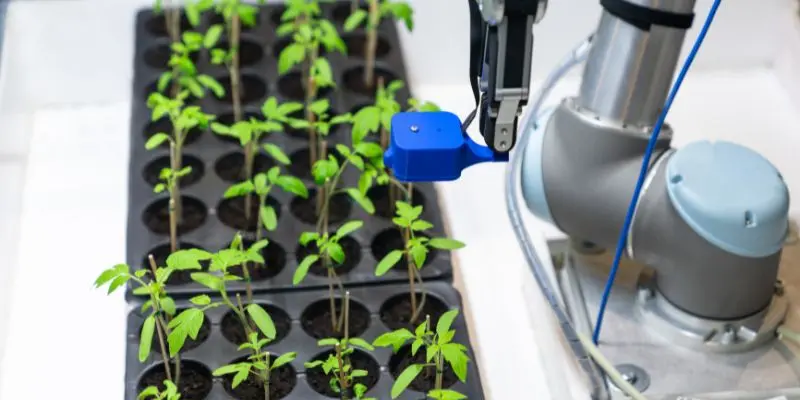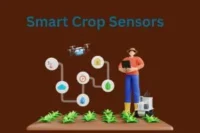Smart Agriculture Sensors: Changing Farming with Technology
Published: 15 Mar 2025

Smart agriculture sensors are at the heart of modern farming techniques, enabling farmers to collect real-time data that improves decision-making, optimizes resource use, and increases crop yields. These sensors, integrated with advanced technologies like IoT, AI, and data analytics, provide invaluable insights into the health of crops, soil conditions, water usage, and other environmental factors. Let’s explore how smart agriculture sensors are transforming the agricultural industry.
1. What Are Smart Agriculture Sensors?
Smart Agriculture Sensors are advanced technologies used in farming to collect real-time data about various environmental and crop conditions. These sensors help farmers monitor soil moisture, temperature, humidity, and other factors that influence crop growth, allowing for precision farming. By using smart sensors, farmers can optimize resource use, increase productivity, reduce waste, and improve crop health through data-driven decisions.
- Soil Moisture Monitoring
- Climate Monitoring (Temperature, Humidity, Light)
- Nutrient Management
- Pest and Disease Detection
- Data-Driven Decisions
- Remote Monitoring
- How They Work: These sensors collect data from their surroundings and transmit it to a central system for analysis. In many cases, the data is then used to automate processes like irrigation or fertilization, making farming more efficient.
So, guys, without wasting time, let’s jump into the article to learn the Agriculture Sensor.
2. Types of Smart Agriculture Sensors
- Soil Sensors:
- Soil moisture, pH levels, temperature, and nutrient content.
- How They Work: These sensors are placed in the soil to provide real-time information on the soil’s health and its ability to support crops.
- Benefits:
- Helps optimize irrigation schedules, reducing water waste.
- Prevents over-fertilization by providing data on soil nutrient levels.
- Optimized Irrigation
- Improved Crop Yield
- Water Conservation
- Cost Savings
- Timely Interventions Increased
- Efficiency Environmental Sustainability

- Climate Sensors:
- Temperature, humidity, rainfall, and light intensity.
- How They Work: Climate sensors track the weather conditions in and around the farm, allowing farmers to plan their activities accordingly.
- Benefits:
- Enables farmers to plan for weather-related challenges like frost or heatwaves.
- Provides insights for optimizing planting and harvest times
- .Accurate Climate Monitoring
- Improved Crop Management
- Better Pest and Disease Control
- Optimized Plant Growth Conditions
- Enhanced Weather Prediction
- Efficient Resource Usage
- Data-Driven Farming Decisions
- Crop Health Sensors:
- Plant growth, leaf health, pest infestations, and disease detection.
- How They Work: These sensors often use visual or thermal imaging to monitor crop health and detect issues early.
- Benefits:
- Detects early signs of diseases or pests.
- Helps farmers apply pesticides or nutrients only when necessary, reducing costs and environmental impact.
- Early Detection of Diseases
- Identifies Nutrient Deficiencies
- Monitors Plant Stress Levels
- Enables Targeted Treatment
- Improves Crop Yield and Quality
- Reduces Pesticide Use
- Enhances Crop Management Efficiency
- Water Quality Sensors:
- Water quality parameters such as salinity, pH, and oxygen levels.
- How They Work: These sensors are used in irrigation systems to monitor the quality of water being used for crops.
- Benefits:
- Ensures that water used for irrigation is suitable for crops, improving yields.
- Reduces water wastage by ensuring optimal water use.
- Monitors Water Contamination Levels
- Ensures Safe Irrigation Water for Crops
- Detects pH and Chemical Imbalances
- Helps Prevent Crop Damage from Poor Water Quality
- Improves Water Management Efficiency
- Promotes Sustainable Farming Practices
- Reduces Water Waste and Cost

3. Benefits of Smart Agriculture Sensors
- Increased Efficiency:
- Smart sensors automate many farming processes, such as irrigation and fertilization, based on real-time data. This reduces manual labor and increases efficiency.
- Benefits:
- Saves time and labor costs.
- Ensures optimal use of resources like water, nutrients, and energy.
- Optimized Resource Usage
- Reduced Wastage of Inputs (water, fertilizers, etc.)
- Faster Decision-Making
- Streamlined Farm Operations
- Lower Operational Costs
- Higher Productivity
- Improved Crop Yield
- Improved Crop Yields:
- : By monitoring soil and crop conditions continuously, smart sensors ensure that crops receive the right amount of water, nutrients, and protection from pests, improving overall crop health.
- Benefits:
- Increases the quantity and quality of crops.
- Helps farmers make decisions that maximize profits by optimizing growing conditions.
- Increased Food Production
- Higher Profits for Farmers
- Enhanced Crop Quality
- Better Resource Utilization
- Reduced Risk of Crop Failure
- Improved Soil Health
- Sustainable Farming Practices
- Sustainability:
- By using smart sensors, farmers can significantly reduce the use of water, pesticides, and fertilizers, leading to more sustainable farming practices.
- Benefits:
- Reduces environmental impact by using resources more efficiently.
- Decreases the carbon footprint of agricultural practices.
- Reduced Environmental Impact
- Conservation of Natural Resources
- Lower Carbon Footprint
- Preservation of Biodiversity
- Efficient Waste Management
- Long-Term Soil Health
- Promotes Eco-Friendly Farming Practices
- Cost Savings:
- : Smart sensors allow farmers to monitor and manage resources in real time, reducing waste and ensuring that only what’s necessary is used.
- Benefits:
- Lowers operational costs related to water, fertilizer, and pesticide use.
- Reduces crop losses due to pests or diseases.
- Reduced Resource Consumption
- Lower Water and Energy Costs
- Decreased Fertilizer and Pesticide Usage
- Minimized Waste and Loss
- More Efficient Labor Management
- Reduced Operational Expenses
- Increased Profit Margins

4. Real-World Applications of Smart Agriculture Sensors
- Precision Irrigation:
- Soil moisture sensors help determine the exact amount of water needed by crops at different stages of growth. This reduces water usage, ensuring crops receive the right amount without wastage.
- Benefits:
- Saves water, a crucial resource in many parts of the world.
- Ensures that crops receive the correct water levels, boosting growth and productivity.
- Integrated Pest Management (IPM):
- Crop health sensors monitor for pest infestations and diseases. Based on the data, farmers can apply pesticides only when needed, minimizing chemical usage and reducing costs.
- Benefits:
- Reduces the use of pesticides and chemicals.
- Helps control pests more effectively and prevent crop damage.
- Greenhouse Monitoring:
- Climate sensors in greenhouses track temperature, humidity, and light, helping to create the optimal growing environment for crops, regardless of external weather conditions.
- Benefits:
- Maximizes crop production in controlled environments.
- Improves the overall climate inside greenhouses, increasing yield and quality.
- Livestock Monitoring:
- Sensors monitor the health, movement, and behavior of livestock, providing data on their well-being and detecting early signs of illness or distress.
- Benefits:
- Improves animal welfare and productivity.
- Allows early detection of diseases, reducing veterinary costs and losses.

5. The Future of Smart Agriculture Sensors
As technology continues to evolve, smart agriculture sensors will become even more advanced, with the integration of artificial intelligence (AI), machine learning (ML), and big data. The future of smart farming will include sensors that can predict weather patterns, optimize planting and harvesting schedules, and even detect soil health on a molecular level.
Conclusion:
Smart agriculture sensors are changing the face of farming by enabling farmers to make more informed, data-driven decisions. These sensors improve crop health, increase yields, reduce costs, and promote sustainability. As technology continues to advance, the role of smart sensors in farming will only continue to grow, helping farmers produce more with fewer resources.
By implementing smart sensors, farmers can take advantage of precision farming techniques, optimize their operations, and contribute to more sustainable agricultural practices, ensuring the future of farming is both profitable and eco-friendly.

- Be Respectful
- Stay Relevant
- Stay Positive
- True Feedback
- Encourage Discussion
- Avoid Spamming
- No Fake News
- Don't Copy-Paste
- No Personal Attacks

- Be Respectful
- Stay Relevant
- Stay Positive
- True Feedback
- Encourage Discussion
- Avoid Spamming
- No Fake News
- Don't Copy-Paste
- No Personal Attacks





